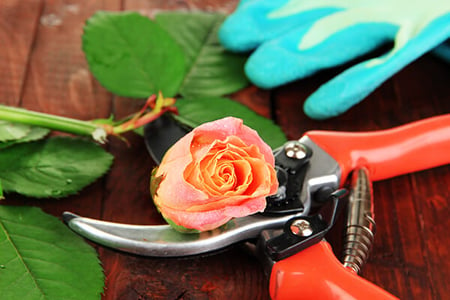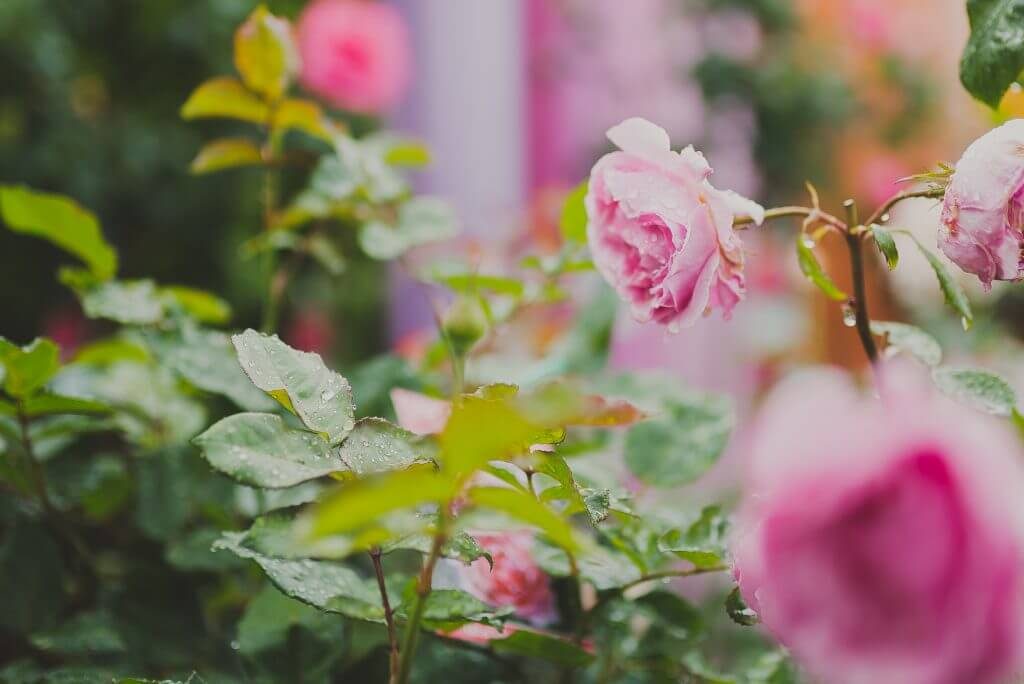The passing of the shortest day brings with it changes in the garden. It is certainly still winter but every day, until the longest day on the 21stof December, the sun is with us for a little longer. The earth slowly begins to warm and, when the ideal temperature is reached for growth, the action begins. July is a very important month in the garden. The tasks completed this month will greatly influence the season of renewal and freshness to come as the Spring arrives.
It’s Rose Time
New season’s roses are still arriving to garden retailers. There is an excellent selection of Hybrid Tea, Floribunda, Old Fashion, David Austin, Flower Carpet, Miniature, Climbing, Ground Cover, Standard and Weeping roses available for planting now.
 Standard Roses
Standard Roses
Standard Roses are selected bush roses that are grafted onto a taller stem (or root stock) to allow the rose to grow at the top of this stem rather than from ground level. Standard Roses are fantastic to add height and focal points to gardens. These can be planted as a single feature or planted in a row for a hedging effect. Standard Roses are also great in feature pots and are a stunning highlight for entrances and patio areas.
Weeping Roses
Weeping Roses are also wonderful features in the garden. These are climbing or rambling roses that are grafted onto a taller stem and will cascade down with a stunning display of flowers.
Planting Roses
Like most things, the better you prepare – the better the rewards. Roses like a sunny, open position in the garden and love a rich and well-drained soil. Prepare the soil before planting by digging in plenty of compost such as Rocky Point ActivGrow or Rocky Point Cow Manure. Once the rose bushes are planted, add a dressing of good quality rose food. Blooming Roses is the ideal premium quality rose food for all types of roses in the garden and in containers. Blooming Roses is an easy to use, pelletised rose food and is all you need to keep your rose gardens happy and blooming.
Rose Pruning
 July is a great month for planting new roses but is also the time to give your existing roses some attention for a fabulous display of colour and fragrance over the flowering season. Unless you live in the really cold areas of the country, July is the best time to prune your roses. In really cold frosty regions, you may need to wait until early August.
July is a great month for planting new roses but is also the time to give your existing roses some attention for a fabulous display of colour and fragrance over the flowering season. Unless you live in the really cold areas of the country, July is the best time to prune your roses. In really cold frosty regions, you may need to wait until early August.
The task of rose pruning can be daunting, but roses are very forgiving and will bounce back beautifully. Winter rose pruning is important as it helps to reduce disease, improve air circulation, allows more light in and encourages good strong new growth. This allows the plant to put the energy into producing an abundance of beautiful blooms as the flowering time arrives.
These are some simple guidelines to follow.
- Begin your pruning of bush roses by removing half of the existing growth. If the rose bush has not been pruned for several seasons, remove two thirds of the existing growth.
- From the remaining plant, remove any dead, diseased or damaged stems.
- Remove any old woody branches.
- Open up the centre of the plant by removing all inward growing stems. This will allow more light and air flow into the rose bush.
- Prune the remaining stems to just above an outward facing bud. The new growth will then grow outwards and produce flowers around the outside of the bush.
- Do not be afraid to prune these stems back to about 30cm to 40cm from the graft. It will look as if you have been harsh, but you will be soon rewarded with nice bushy plants full of lush new growth.
- These final cuts should be at about a 45 degree angle. Make the cut so it is sloping away from the bud so that rain and dew won’t collect in the area where the bud forms onto the stem. This will help control any fungal problems.
Once pruning is complete give the pruned rose bush a good spray with All Seasons Oil or Pest Oil to control pests that are hiding ready for the new growth to appear. Fertilise with Blooming Roses, mulch with a nice thick layer of your favourite Rocky Point mulch and you will be rewarded with lots of fresh new growth and an abundance of beautiful fragrant blooms to delight the senses.
Pruning of Deciduous Fruiting Trees
 There is a vast selection of wonderful fruiting trees, shrubs and vines to plant during July.
There is a vast selection of wonderful fruiting trees, shrubs and vines to plant during July.
As with roses, July is the ideal time to prune back most existing deciduous fruiting plants. Avoid pruning Cherries, Apricots and Kiwi fruit vines until the warmer weather as these tend to bleed if pruned through winter.
Basically, there are three shapes for the winter pruning of deciduous fruit trees such as Apples, Peaches, Pears, Plums and Nectarines.
- Vase shape – The traditional open centre with 3 to 4 main leaders for framework.
- Central leader or pyramid – A more modern method as it takes less space and trees can be kept narrow. Ballerina apples are very suited to this method.
- Espalier – An ideal method of training and pruning where space is limited.
Helpful Tips
- Focus on pruning to the shape you want.
- Always remember that the strongest new growth will come from the first bud below where the pruning cut is made. Prune to regulate growth, allow light in and encourage flowers and fruit.
- In years 1 and 2 prune hard to make sturdy framework and shape the tree.
- Pruning for continuous fruiting is important once the tree has established. This is relatively easy once you know where the fruit will form. Apples, pears, quinces, plums, and apricots fruit on the same spurs for several years. New spurs form as old ones die.
Once the pruning of fruiting trees is complete, fertilise with a generous application of an organic fertiliser such as Terra Firma Organic Life and follow up with another application as the new growth and flowers are appearing. Mulch around your tree without mulching up the base of the tree. Rocky Point Sugar Cane Mulch is just one of the Rocky Point mulches that are perfect for the task.
For any pruning or garden advice, your nearest garden centre or plant seller will help you with the best local advice. Many garden retailers host pruning workshops during July. Watch out for these events as they are a great opportunity to receive the hints and tips from the experts.
July is also an important time of pruning in warmer areas of the country. Fruiting trees in warmer climates require more regular pruning as they grow quickly and produce lots of fruit over a long period. For the best local advice visit your local garden centre or garden retailer.
Garden Pruning
While the pruners are out, July is the perfect time to prune back, tidy up and shape many trees, shrubs, perennials and hedges in the garden. Avoid pruning evergreen plants that will flower in the spring. Wait until after flowering before pruning happens. If a major cut back of trees or shrubs that have grown too large is required, even if it means forfeiting flowers or fruit for a year, July is the time to achieve this. Most hedging and screening plants respond very well to a good July pruning. Fertilise any plants that have been pruned with a high-quality plant food such as Terra Firma Native & Shrub or Terra Firma Organic Life to encourage lots of fresh new growth.
In the Veggie Patch.
 Prepare your plot before planting by digging in plenty of compost such as Rocky Point ActivGrow or Rocky Point Cow Manure and a generous application of Blood and Bone. Terra Firma Blood and Bone is not a hard to spread powder like most Blood and Bone products but, are easy to use pellets with added fully composted chicken manure. Very convenient, certified organic and full of garden goodness.
Prepare your plot before planting by digging in plenty of compost such as Rocky Point ActivGrow or Rocky Point Cow Manure and a generous application of Blood and Bone. Terra Firma Blood and Bone is not a hard to spread powder like most Blood and Bone products but, are easy to use pellets with added fully composted chicken manure. Very convenient, certified organic and full of garden goodness.
Tropical, subtropical and arid regions continue to enjoy lots of growth in the edible garden. Asian Greens, Beetroot, Broccoli, Cabbage, Cauliflower, Chives, Celery, Kale, Leek, Lettuce, Radish, Rocket, Silverbeet, Spring Onion, Tomato and Strawberry plants can all be planted now. Most herbs can also be planted now including Basil (in frost free areas), Coriander, Thyme, Marjoram, Oregano, Dill and Mint.
Cooler regions are able to plant Artichoke, Broad Beans, Brussels Sprouts, Coriander, Spinach, Garlic, Kale, Lettuce, Mint, Onion, Radish, Silverbeet and Snow Peas.
In suitable regions, Asparagus and Rhubarb crowns can be planted now and provide years of tasty harvests. Certified Seed Potatoes are available and can be planted once the risk of frosts has passed.
Rocky Point Sugar Cane Mulch is the perfect mulch for around your vegetable and herb plants. Sugar Cane Mulch looks great, it is weed free, will help to retain moisture and to suppress weeds.
July is a busy month in the garden to keep growing and to continue to achieve great things.
_MEB.png?width=842&height=596&name=RP_HorizontalColour(R)_MEB.png)



